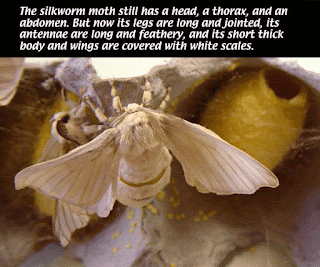LIFE CYCLE OF SILKWORMS
The total life-cycle of a Silkworm ranges from 6-8 weeks. Generally, the warmer the weather, the quicker the Silkworm will complete its life-cycle, however, other factors such as humidity and exposure to sunlight are also very important. Ideally, Silkworms will experience 12 hours of sunlight, and 12 hours of darkness per day, a temperature of 23-28 degrees Celsius, as well as humidity levels of 85-90%. Under these conditions, your eggs should hatch in a period of 7-10 days. However, it is very hard to achieve these conditions without an incubator, and it is common practise to just make do with the weather in the area in which you live.
The life cycle of Bombyx mori demonstrates the most advanced form of metamorphosis. The serial progressions of four distinct stages of development complete one generation of the species;
1) Egg (ova),
2) Larvae,
3)Pupa and
4)Imago.
Following are the step by step lifecycle of silkworms.
1) Life Cycle Overview.
2) Large Silkworms eating leaves.
3) Body parts of Silkworm.
4) Silkworm Eating Mulberry leaves.
5) Closeup of the body of a silkworm.
6) Another closeup view of a silkworm.
7) The vein along the back of the silkworm.
8) Silkworm resting before molting.
9) Another view of the silkworm resting before molting.
10) Silkworm starting to spin a cocoon.
11) Cocoon begins to form
12) Silkworm makes messy poop.
13) Spinning the cocoon.
14) Finished cocoon.
15) Inside the finished cocoon.
16) Yet another inside view of the cocoon.
17) Moth starting to emerge from the cocoon.
18) Moth half out of the cocoon.
19) Empty cocoon after the moth has emerged.
20) Empty cocoon showing "pee" stain.
21) Adult standing on the empty cocoon.
22) Newly-emerged adult with crumpled wing.
23) Adult moth next to empty cocoon.
24) Adult and eggs resting on egg carton.
25) Adult with diagram showing body parts.
26) Male moth fluttering wings.
27) Adult female moth resting.
28) Moths mating while sitting on cocoon.
29) Closeup of moths mating.
30) Female moths with eggs on egg carton.
31) Lots of brown eggs that will hatch soon.
32) Closeup of eggs laid on egg carton.
33) Shed skins from worms and pupa.
34) Loose silk pulled from outside of cocoon (FLOSS).
35) Cocoon for Silk yarn Reeling purpose.
A) Bivoltine Hybrid Cocoons.
B) Cross Breed Cocoons.
Bibliography:.
1) http://www.suekayton.com/Silkworms/lifecycle.htm
2) http://www.biologydiscussion.com/animals-2/lifecycle-of-silkworm-with-diagram/2655
3) https://everythingsilkworms.com.au/silkworms/life-cycle-of-a-silkworm/












































